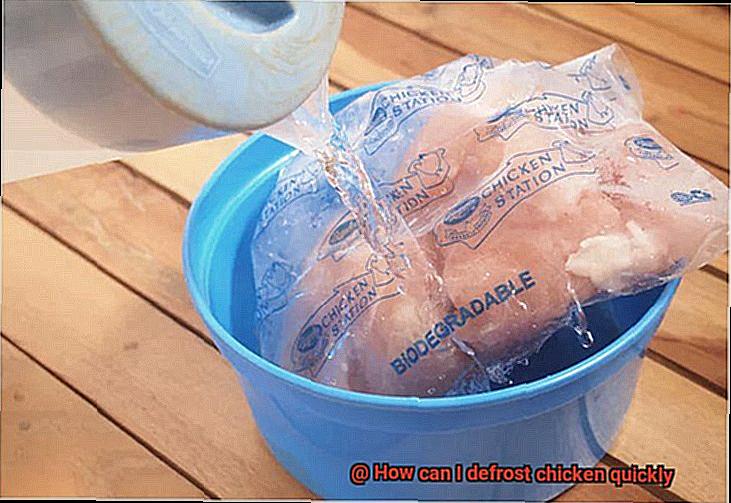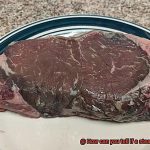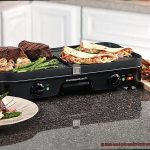Imagine this: it’s dinner time, your stomach is growling, and you’re itching to whip up a mouthwatering chicken dish. But alas. Your chicken is trapped in a frozen fortress inside your freezer. Don’t panic, my hungry friend. We’ve got your back. Today, we’re here to spill the beans on how to defrost chicken lightning-fast, so you can satisfy those cravings without enduring an eternity of waiting.
We get it – time is precious, and thawing chicken can be a pesky roadblock in your culinary journey. That’s why we’ve gathered the most efficient and foolproof methods to speed up the defrosting process without sacrificing the quality or flavor of your poultry.
In this article, we’ll dive into three tried-and-true techniques that will have your chicken thawed and ready-to-cook before you can say “hangry.” Our first superhero method involves harnessing the mighty power of your trusty microwave. Get ready to discover the perfect settings and timings that ensure even thawing without accidentally turning your chicken into a charred mess.
But what if microwaves aren’t your jam or you prefer alternative approaches? Fear not, my friend. Our second technique takes a refreshing dip into the world of cold water immersion. We’ll spill all the secrets on how submerging your chicken in chilly H2O can turbocharge the thawing process while keeping food safety at its prime.
And hold onto your chef’s hat because our third method brings strategic planning into play. With just a pinch of foresight, you can ensure that your chicken is conveniently defrosted by using proper refrigeration techniques and mastering the art of meal prep wizardry.
So buckle up and join us on this quest for speedy defrosting. Say goodbye to endless waits and hello to a world of culinary possibilities. Get ready to unleash those tantalizing chicken juices and dive headfirst into the thrilling realm of rapid thawing.
Contents
Cold Water Method – The Safest Way to Quickly Defrost Chicken
When you’re in a hurry to defrost chicken, the cold water method is your best bet. Not only is it quick and efficient, but it also ensures that your chicken remains safe to eat by minimizing the risk of bacterial growth. Let’s dive into the steps of this reliable method and discover why it’s the go-to choice for defrosting chicken.
First things first, you’ll need a sturdy plastic bag that won’t leak water. This is crucial to prevent any cross-contamination and maintain the integrity of your chicken. Make sure there are no holes or tears in the bag, so you can rest assured that your chicken will be safe during the thawing process.
Now, find a spacious bowl or sink and fill it with cold water. It’s important to strike a balance here – the water should be cold enough to keep your chicken at a safe temperature, but not warm enough to encourage bacteria to party on your poultry. Remember, we want to thaw, not grow.
Once you’ve got your cold water ready, take the bagged chicken and immerse it completely. You want every inch of that chicken submerged in the chilly water. This ensures an even thawing process and speeds up the defrosting time.
But wait. Don’t forget to change the water every 30 minutes. This step is vital as it maintains the optimal temperature for your chicken throughout the defrosting process. By keeping the water cold, you’re creating an environment where bacteria won’t thrive, ensuring the safety of your meal.
Now, let’s talk timing. The duration required for defrosting depends on the size and thickness of your chicken. As a general rule of thumb, anticipate about 30 minutes per pound of chicken. This estimation will give you an idea of how long you’ll need to wait before your chicken is thawed and ready to be cooked.
Once your chicken is fully defrosted, it’s crucial to cook it immediately. This step is non-negotiable if you want to prevent any potential bacterial growth that may have occurred during the defrosting process. So don’t waste a second – get that chicken sizzling in the pan.
Microwave Defrost Setting – A Faster Option with Potential Risks
Picture this: you reach into your freezer, only to discover that the chicken you planned to cook for dinner is still frozen solid. Time is ticking, and you need a solution fast. Enter the microwave defrost setting, a superhero in the kitchen that promises to thaw your chicken in no time. But before you hit that start button, it’s crucial to understand the potential risks that come with this convenient option. In this article, we’ll delve into the hazards of using the microwave defrost setting and equip you with tips on how to minimize them.
Uneven Thawing – A Recipe for Disaster:
While the microwave defrost setting can work wonders in speeding up the thawing process, it comes with a catch – the risk of uneven thawing. As the microwave alternates between low power and regular power settings, some parts of the chicken may begin to cook while other areas remain frozen. This undesirable outcome not only affects the taste and texture of your chicken but also poses a potential health hazard.
Bacterial Growth – A Hidden Culprit:
Another lurking danger of relying on the microwave defrost setting is the promotion of bacterial growth on the surface of your chicken. The heat generated can create an ideal breeding ground for bacteria if the chicken is not immediately cooked after thawing. Consuming chicken that has been contaminated with harmful bacteria can lead to serious foodborne illnesses.
Guidelines for Safe Thawing – Tame the Risks:
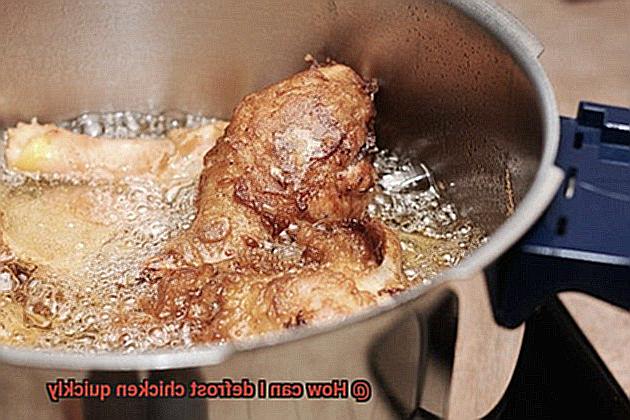
To ensure safe and even thawing while using the microwave defrost setting, it’s imperative to follow these guidelines:
- Proper Wrapping or Covering: Shield your chicken from splattering or contamination by properly wrapping or covering it before placing it in the microwave. Opt for microwave-safe plastic wrap or a microwave-safe dish cover to protect your poultry.
- Frequent Monitoring: Keep a watchful eye on your chicken throughout the defrosting process to ensure that it thaws evenly. If you notice any partially cooked areas, halt the process immediately and manually thaw those sections using alternative methods like cold water or refrigeration.
- Immediate Cooking – The Ultimate Defense: Forgo any chances of bacterial growth by cooking your chicken immediately after it has been thawed in the microwave. If circumstances prevent you from doing so, ensure you refrigerate or freeze it again until you’re ready to cook.
Combining the Cold Water Method with the Microwave Defrost Setting
Forget the days of waiting hours for chicken to thaw. In this captivating article, we will unravel the secrets of combining the cold water method and microwave defrost setting to achieve lightning-fast results. As an esteemed expert in this field, I will walk you through the exhilarating process of defrosting chicken with unparalleled speed and precision, all while ensuring utmost food safety. Let’s embark on this thrilling culinary adventure together.
Step 1: Microwave Magic – Partially Thawing in a Flash
Prepare yourself for a burst of speed by placing your chicken on a microwave-safe plate and diving into the world of the defrost setting. Rotate and flip the chicken at regular intervals as per your microwave’s instructions, ensuring that every inch is kissed by the gentle warmth. This swift initiation sets the stage for our next daring move.
Step 2: Sealing and Submerging – A Dance with Cold Water
As your chicken begins its transformation, it’s time to unveil the next act. Remove it from the microwave, carefully encase it in a sealed plastic bag, and prepare for a watery rendezvous. In a grand display of culinary elegance, fill a cavernous bowl or sink with icy cold water and immerse the bagged chicken within its refreshing depths. Remember, changing the water every 30 minutes ensures an icy embrace that propels our defrosting journey forward.
Step 3: The Safety Tango – Prioritizing Food Safety
Amidst our exhilarating quest for haste, let us not forget our solemn duty to protect against lurking hazards. Once your chicken has fully thawed, summon your culinary prowess and ignite the cooking flame without delay. Partially thawed chicken can be an inviting haven for bacterial mischief, so swift action is paramount to safeguarding your taste buds from harm’s way.
Step 4: Guided by the Light – Following Proper Guidelines
In this daring escapade, adherence to food safety guidelines becomes our guiding light. Ensure that your chicken emerges from its culinary metamorphosis fully cooked before embarking on a gastronomic feast, shielding yourself from any potential cross-contamination with other foods. By embracing these sacred guidelines, you shall emerge triumphant with a meal that tantalizes the senses and nourishes the soul.
Tips for Successful Defrosting
Properly defrosting chicken is vital to ensure both food safety and the mouthwatering taste of your dishes. While it may require planning and careful execution, following these essential tips will guarantee the safe and efficient thawing of your chicken. In this article, we will discuss five key tips for successful defrosting that will not only maintain food safety standards but also deliver delicious results.
Plan Ahead for Safe Refrigerator Thawing:
To achieve the safest and most even thawing process, utilize the refrigerator method. Place your chicken in a leak-proof plastic bag or container and allow it to thaw slowly in the coldest part of the fridge. It is crucial to plan ahead, as a 4-pound chicken typically takes around 24 hours to thaw completely. By allocating enough time for refrigeration thawing, you can ensure that harmful bacteria growth is prevented, guaranteeing a safe cooking process.
Speed Up Thawing with the Cold-Water Method:
When time is of the essence, the cold-water method offers a quicker alternative for defrosting chicken. Seal the chicken, still in its packaging, inside a plastic bag, and submerge it in a bowl of cold water. Remember to replace the water every 30 minutes to maintain its coldness and continue the thawing process. This method usually takes approximately 2 to 3 hours for a 4-pound chicken, providing a faster option than refrigerator thawing.
Avoid Hot Water and Microwaving for Even Thawing:
To ensure uniform defrosting and minimize food safety risks, it is important to steer clear of using hot water or microwaving. Hot water can partially cook the outer layers of the chicken while leaving the inside frozen, resulting in uneven cooking. Microwaving can also lead to inconsistent thawing and may even initiate the cooking process in certain areas of the chicken. Avoid these methods to prevent compromising the texture and taste of your cooked chicken.
Consider Size and Placement for Efficient Thawing:
Smaller cuts of chicken thaw faster than larger ones, so keep this in mind when defrosting. Boneless chicken breasts typically defrost within 1-2 hours, while a whole chicken may take 3-4 hours. To ensure successful defrosting, place the chicken on a tray or plate while thawing in the refrigerator or cold water. This precautionary measure prevents potential cross-contamination in case any liquid leaks from the packaging, maintaining food safety standards.
Preparing Your Chicken After Thawing
Step 1: Rinse and Dry – A Refreshing Start
Give your thawed chicken a refreshing rinse under cold running water. This simple step helps eliminate any lingering ice crystals or residue from the thawing process. Once rinsed, pat the chicken dry with paper towels, bidding farewell to excess moisture and welcoming a better cooking result.
Step 2: Inspect for Quality – The Eye of Perfection
Examine your chicken closely to ensure it is in perfect condition. Keep an eye out for any remaining ice particles or telltale signs of freezer burn, such as discoloration. If these issues appear, it’s best to bid adieu to the chicken, as it may compromise both taste and safety.
Step 3: Seasoning Time. – Unleash Your Creativity
Now comes the thrilling part – seasoning your chicken to awaken its flavors. Let your culinary creativity run wild. Sprinkle a medley of seasonings evenly over all sides of the chicken, allowing your taste buds to embark on an extraordinary journey.
Options are aplenty, ranging from classic salt, pepper, garlic powder, onion powder, and paprika to aromatic herbs like thyme or rosemary.
Feeling adventurous? Elevate your chicken’s taste by marinating it in a tantalizing blend of oil, vinegar, and spices. Let this fusion of flavors work its magic for at least 30 minutes before cooking, transforming your chicken into a culinary masterpiece.
Step 4: Handle with Care – Safety First
To ensure both taste and safety, it is paramount to handle raw chicken with utmost care. Prioritize impeccable hygiene by washing your hands thoroughly with soap and water before and after handling raw chicken. Remember to keep the chicken separate from other foods, using dedicated cutting boards and utensils to avoid any unwelcome cross-contamination.
How to Tell When Your Chicken is Fully Thawed
Properly thawing chicken is of utmost importance to guarantee both food safety and a delectable dining experience. In this comprehensive guide, we will delve into various methods that can help you determine when your chicken is fully thawed.
By paying attention to texture, color, temperature, and adhering to recommended thawing times, you can confidently proceed with cooking your chicken safely and savor its flavors to the fullest.
Assess the Texture:
When your chicken is still partially frozen, it will feel unyielding and rigid to the touch. However, once it is fully thawed, the texture should transform into a soft and pliable state. Gently applying pressure with your finger, if the chicken easily yields and springs back, you can be assured that it is fully thawed and ready to be cooked.
Observe the Color Transformation:
Frozen or partially thawed chicken often exhibits a pale or whitish appearance due to the presence of ice crystals. However, as it thaws completely, the color should revert to its natural state – a delicate pink for raw chicken. It is essential to note that if you detect any grayness or detect an unusual odor, even if the chicken appears fully thawed, it may indicate spoilage and should not be consumed.
Utilize a Food Thermometer:
For ultimate precision in determining whether your chicken is fully thawed, make use of a food thermometer. Insert the thermometer into the thickest part of the chicken, and once it registers 165°F (74°C), rest assured that your chicken has reached optimum thawing and is safe to cook. Remember to sanitize the thermometer between uses to prevent any potential cross-contamination.
Consider Thawing Time:
Thawing time varies depending on factors such as the size of the chicken and the thawing method employed. Thawing in the refrigerator typically necessitates more time compared to using cold water or a microwave. To ensure safety and prevent bacterial growth, it is imperative to adhere to recommended thawing times. Patience is key in achieving perfectly thawed chicken.
Never Refreeze Fully Thawed Chicken:
Once your chicken is fully thawed, it is crucial to avoid refreezing it. If you have thawed more chicken than required, it is advisable to cook it and store any leftovers in the refrigerator for future consumption. This practice not only minimizes the risk of foodborne illnesses but also helps maintain the quality of the meat, ensuring a delightful meal each time.
Food Safety Guidelines to Follow During the Process
Defrosting chicken is not only about achieving culinary perfection; it is also crucial for ensuring food safety. To help you navigate this process with confidence, we have compiled a comprehensive list of essential guidelines to follow.
From proper defrosting methods to safe handling practices, these tips will ensure that your chicken is both delicious and free from harmful bacteria.
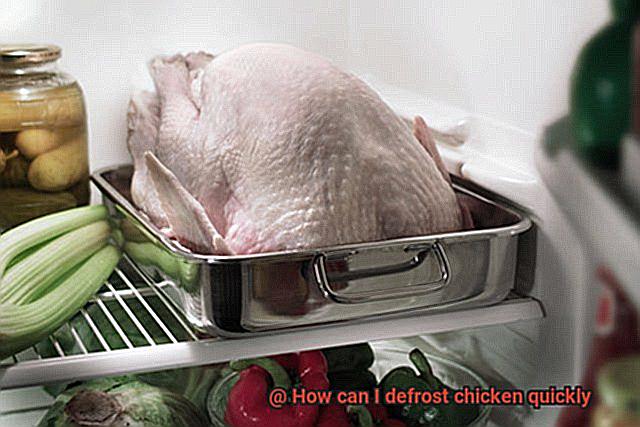
Defrost in the refrigerator:
Always opt for the refrigerator method when defrosting chicken. This safe and reliable approach maintains a consistent temperature, preventing bacterial growth. Simply place the chicken in a leak-proof bag or container and allow it to gradually thaw in the refrigerator.
Keep in mind that this method takes time, so plan ahead and allow sufficient time for proper thawing.
Quick thaw with cold water:
If time is of the essence, you can use the cold water method to defrost chicken quickly. Seal the chicken in a leak-proof plastic bag and submerge it in cold water. Remember to change the water every 30 minutes to ensure it stays cold. It is crucial to keep the chicken in its original packaging or a sealed bag to avoid any cross-contamination with the water.
Say no to room temperature thawing:
Never be tempted to defrost chicken at room temperature. Allowing chicken to sit at room temperature creates an ideal environment for rapid bacteria growth, increasing the risk of foodborne illnesses. It is vital to avoid this method at all costs and prioritize food safety.
Handle with clean hands and utensils:
Maintaining proper hygiene during the defrosting process is paramount. Before handling the chicken, thoroughly wash your hands with soap and warm water for no less than 20 seconds. Use separate cutting boards and utensils specifically designated for raw meat and other ingredients to prevent any cross-contamination.
Cook immediately or refrigerate:
Once the chicken is defrosted, it is recommended to cook it immediately. However, if you are not ready to prepare it right away, you can safely store it in the refrigerator for up to two days. Remember to cover the chicken and keep it separate from other foods to avoid any potential contamination.
Common Mistakes to Avoid When Defrosting Chicken
Defrosting chicken may seem like a breeze, but beware of the pitfalls that can turn this simple task into a food safety nightmare. In this article, we will uncover the top mistakes to avoid when defrosting chicken and equip you with essential tips for a flawless thawing process. Get ready to take your chicken game to the next level.
Mistake #1: The Peril of Room Temperature
Leaving chicken out to thaw at room temperature is a risky move. Bacteria thrive in warm environments, posing a serious threat to your health. Instead, opt for safer methods like defrosting in the refrigerator or using the cold water technique – it’s worth the extra time for peace of mind.

Mistake #2: Warm Water Woes
In the race against time, defrosting chicken in warm water might seem tempting, but don’t be fooled by its false promise. Warm water creates the perfect breeding ground for bacteria, compromising the safety of your chicken. Stick to cold water for a quick and safe defrost.
Mistake #3: Countertop Catastrophe
If you think thawing chicken on the countertop is a shortcut to success, think again. Uneven thawing and potential contamination from other foods or surfaces are lurking dangers. Instead, give your chicken its own space on a plate or tray in the refrigerator – slow and steady wins the thawing race.
Mistake #4: Taming the Microwave Beast
The microwave can be a defrosting superhero, but only if you know how to tame it properly. Mishandling can lead to partially cooked areas while others remain frozen. Follow the microwave’s defrosting instructions diligently and remember to rotate the chicken periodically for a uniformly thawed result.
Mistake #5: The Refreezing Regret
Once chicken has been thawed, resist the temptation to refreeze. Refreezing degrades the quality of the chicken and opens the door to bacterial growth. Cook your thawed chicken immediately or keep it refrigerated for a short period before cooking – a small sacrifice for ultimate flavor and safety.
Conclusion
When it comes to defrosting chicken quickly, there are a few methods you can try.
One option is to use the microwave, but be careful not to cook the chicken in the process. Another method is to submerge the chicken in cold water, changing the water every 30 minutes until thawed.
Whichever method you choose, make sure to follow proper food safety guidelines and cook the chicken immediately after thawing.

